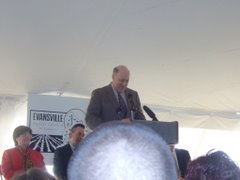"The Council believes that the rules should establish absolute noise limits (as opposed to noise limits relative to ambient noise levels). Measurements using above ambient noise levels may be helpful for assessing potential for annoyance,28 but are not correlated with known adverse health effects. The overwhelming majority of studies relating to noise and human health have assessed effects from absolute noise levels rather than relative noise levels. As a result, the Council believes that use of absolute noise limits in the rules is a practice based upon a larger volume of scientific evidence.
After surveying the peer-reviewed scientific research regarding the health impacts of wind energy systems, the Council favors a noise performance standard which limits the noise attributable to wind energy systems to a year round standard of 45 dBA at night and 50 dBA during the day. This recommendation is a departure from past practice for wind projects reviewed at the state level in Wisconsin; however, the Council believes that this departure is in the public interest.
The best available scientific evidence specific to wind turbine noise suggests that 45 dBA (measured outside of a residence) is the noise threshold above which there is a small but statistically significant increase in self-reported sleep disturbance.29 This evidence does not allow for a conclusion regarding whether there are seasonal differences in self-reported sleep disturbance.30 As a result, the Council believes this noise performance standard should be applied year-round for nonparticipating landowners. The Council believes that property owners should be permitted to waive the noise performance standards. The Council did not find any data regarding specific health impacts of wind turbine noise in excess of 50 dBA. Evidence from studies of other sources of environmental noise, suggests that a daytime noise threshold of 50 dBA is well below the threshold at which measurable adverse health effects (e.g. hearing impairment, high blood pressure) from noise are seen.31,32 The Council believes these proposed noise performance standards are moderately conservative when compared with similar standards found in most other states.33,34"
Saturday, August 14, 2010
State of Wis Wind Siting Council Recommends DBA limits for daytime, night
Subscribe to:
Post Comments (Atom)






























No comments:
Post a Comment